Investigating Social Determinants of Health: A UK Tooth Decay Analysis
VerifiedAdded on 2023/05/30
|14
|3745
|196
Report
AI Summary
This report examines the social determinants of health and their impact on tooth decay among children in the UK. It begins by highlighting the prevalence of tooth decay and its consequences, including hospital admissions and school absences. The report identifies key social factors such as income inequalities, education, and nutrition as significant contributors to the disease. It discusses the epidemiology of tooth decay at local, national, and global levels, emphasizing the role of age and access to healthcare. The report also explores the impact of social class and education on health outcomes, linking them to the availability of resources and informed health choices. Finally, it references various studies and reports to support the claim that social inequalities significantly influence health disparities, including oral health, in the UK. Desklib offers a wealth of resources, including similar solved assignments and past papers, for students seeking to deepen their understanding of public health issues.
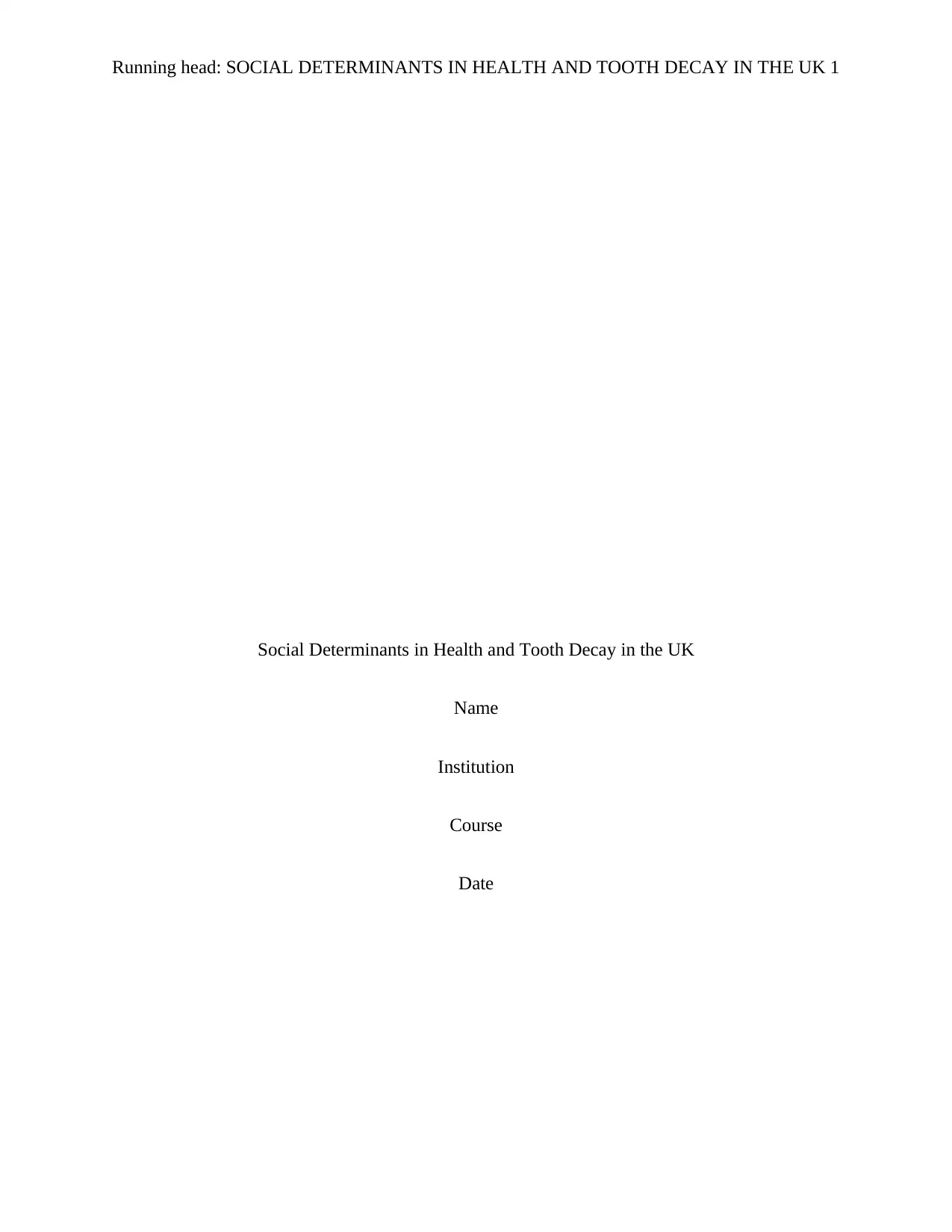
Running head: SOCIAL DETERMINANTS IN HEALTH AND TOOTH DECAY IN THE UK 1
Social Determinants in Health and Tooth Decay in the UK
Name
Institution
Course
Date
Social Determinants in Health and Tooth Decay in the UK
Name
Institution
Course
Date
Paraphrase This Document
Need a fresh take? Get an instant paraphrase of this document with our AI Paraphraser
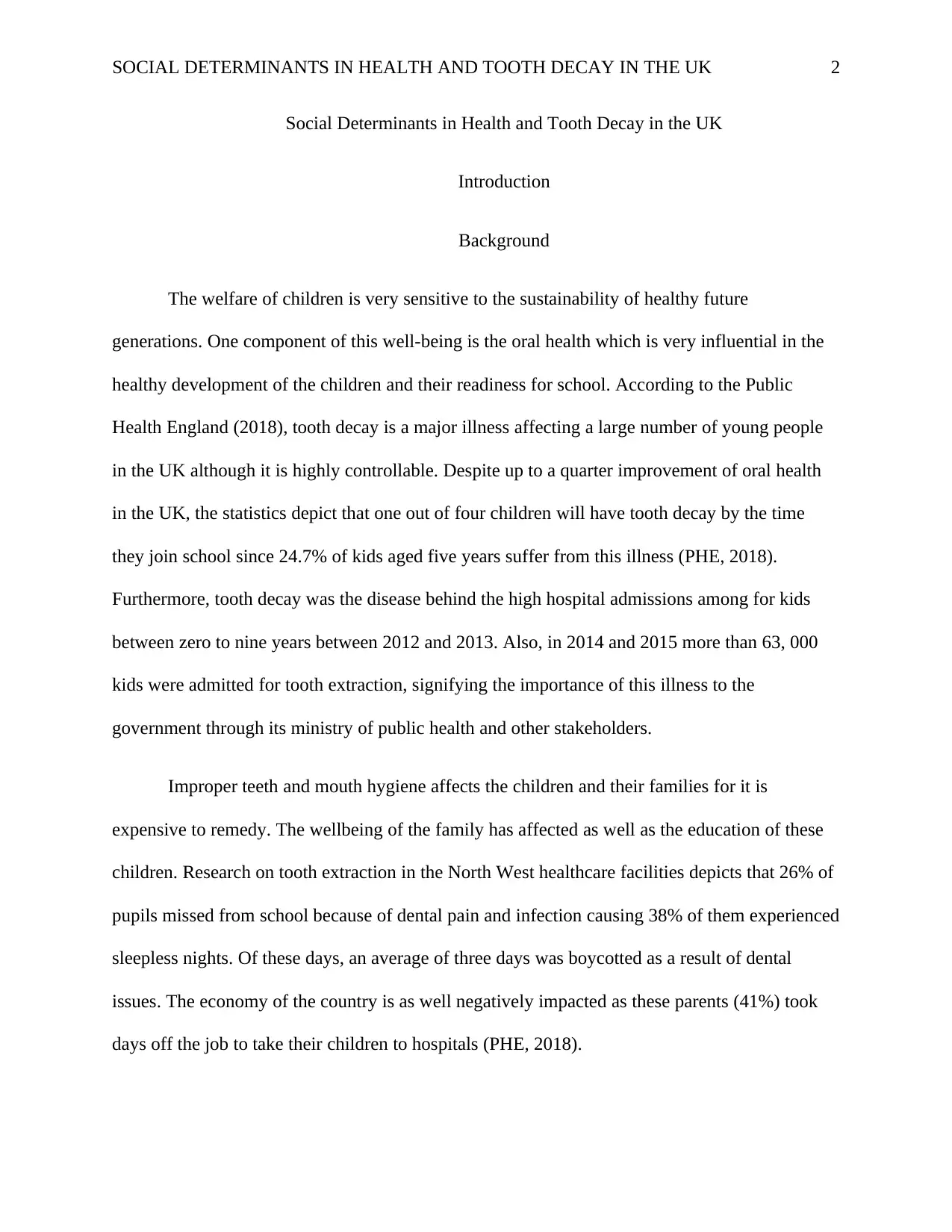
SOCIAL DETERMINANTS IN HEALTH AND TOOTH DECAY IN THE UK 2
Social Determinants in Health and Tooth Decay in the UK
Introduction
Background
The welfare of children is very sensitive to the sustainability of healthy future
generations. One component of this well-being is the oral health which is very influential in the
healthy development of the children and their readiness for school. According to the Public
Health England (2018), tooth decay is a major illness affecting a large number of young people
in the UK although it is highly controllable. Despite up to a quarter improvement of oral health
in the UK, the statistics depict that one out of four children will have tooth decay by the time
they join school since 24.7% of kids aged five years suffer from this illness (PHE, 2018).
Furthermore, tooth decay was the disease behind the high hospital admissions among for kids
between zero to nine years between 2012 and 2013. Also, in 2014 and 2015 more than 63, 000
kids were admitted for tooth extraction, signifying the importance of this illness to the
government through its ministry of public health and other stakeholders.
Improper teeth and mouth hygiene affects the children and their families for it is
expensive to remedy. The wellbeing of the family has affected as well as the education of these
children. Research on tooth extraction in the North West healthcare facilities depicts that 26% of
pupils missed from school because of dental pain and infection causing 38% of them experienced
sleepless nights. Of these days, an average of three days was boycotted as a result of dental
issues. The economy of the country is as well negatively impacted as these parents (41%) took
days off the job to take their children to hospitals (PHE, 2018).
Social Determinants in Health and Tooth Decay in the UK
Introduction
Background
The welfare of children is very sensitive to the sustainability of healthy future
generations. One component of this well-being is the oral health which is very influential in the
healthy development of the children and their readiness for school. According to the Public
Health England (2018), tooth decay is a major illness affecting a large number of young people
in the UK although it is highly controllable. Despite up to a quarter improvement of oral health
in the UK, the statistics depict that one out of four children will have tooth decay by the time
they join school since 24.7% of kids aged five years suffer from this illness (PHE, 2018).
Furthermore, tooth decay was the disease behind the high hospital admissions among for kids
between zero to nine years between 2012 and 2013. Also, in 2014 and 2015 more than 63, 000
kids were admitted for tooth extraction, signifying the importance of this illness to the
government through its ministry of public health and other stakeholders.
Improper teeth and mouth hygiene affects the children and their families for it is
expensive to remedy. The wellbeing of the family has affected as well as the education of these
children. Research on tooth extraction in the North West healthcare facilities depicts that 26% of
pupils missed from school because of dental pain and infection causing 38% of them experienced
sleepless nights. Of these days, an average of three days was boycotted as a result of dental
issues. The economy of the country is as well negatively impacted as these parents (41%) took
days off the job to take their children to hospitals (PHE, 2018).

SOCIAL DETERMINANTS IN HEALTH AND TOOTH DECAY IN THE UK 3
Among the risk factors for this disease are social disparities of income inequalities,
education, employment as well as nutrition whereby some children are fed in free sugar foods.
These social inequalities hint on the social factors of health as contributing elements to the
prevalence of this disease.
Epidemiology
The carries disease is at the local, national and international level influenced by the above
social factors of health. Another critical factor to highlight is age whereby statistics show that
this disease is prevented among children aged about five years. Some of the reasons for this
prevalence is lack of information about tooth hygiene since, poor cleaning methods and foods
mostly used by these children such as sugary foods which are enhancing factors for the
development of the disease. According to statistics, above 55% of children of about five years in
2015 in Blackburn Darwen were suffering from tooth decay (Shuttle, 2018). These high
percentile is attributed to lack or fewer visits to healthcare care centers for by the parents of these
children for a checkup to prevent this disease. Some parents are either ignorant or lack
knowledge on this disease prompting for mass sensitization initiative. For this reason, the
government of UK has come up with a sensitization program of “Starting well: Smile for life”
investing about 375k Euros targeting 4, 000 children in Lancashire and South Cumbria for the
following two years (Shuttle, 2018). Such a commitment by the government to this disease
highlights the importance of the illness and its effects.
In the global context, dental illness is prevalent among adults affecting a total of 2.4
million worldwide whereby as a result of unchecked cases in early life. Also, about 621 million
children are victims of this disease which frequently inflicts pain and can lender someone
Among the risk factors for this disease are social disparities of income inequalities,
education, employment as well as nutrition whereby some children are fed in free sugar foods.
These social inequalities hint on the social factors of health as contributing elements to the
prevalence of this disease.
Epidemiology
The carries disease is at the local, national and international level influenced by the above
social factors of health. Another critical factor to highlight is age whereby statistics show that
this disease is prevented among children aged about five years. Some of the reasons for this
prevalence is lack of information about tooth hygiene since, poor cleaning methods and foods
mostly used by these children such as sugary foods which are enhancing factors for the
development of the disease. According to statistics, above 55% of children of about five years in
2015 in Blackburn Darwen were suffering from tooth decay (Shuttle, 2018). These high
percentile is attributed to lack or fewer visits to healthcare care centers for by the parents of these
children for a checkup to prevent this disease. Some parents are either ignorant or lack
knowledge on this disease prompting for mass sensitization initiative. For this reason, the
government of UK has come up with a sensitization program of “Starting well: Smile for life”
investing about 375k Euros targeting 4, 000 children in Lancashire and South Cumbria for the
following two years (Shuttle, 2018). Such a commitment by the government to this disease
highlights the importance of the illness and its effects.
In the global context, dental illness is prevalent among adults affecting a total of 2.4
million worldwide whereby as a result of unchecked cases in early life. Also, about 621 million
children are victims of this disease which frequently inflicts pain and can lender someone
⊘ This is a preview!⊘
Do you want full access?
Subscribe today to unlock all pages.

Trusted by 1+ million students worldwide
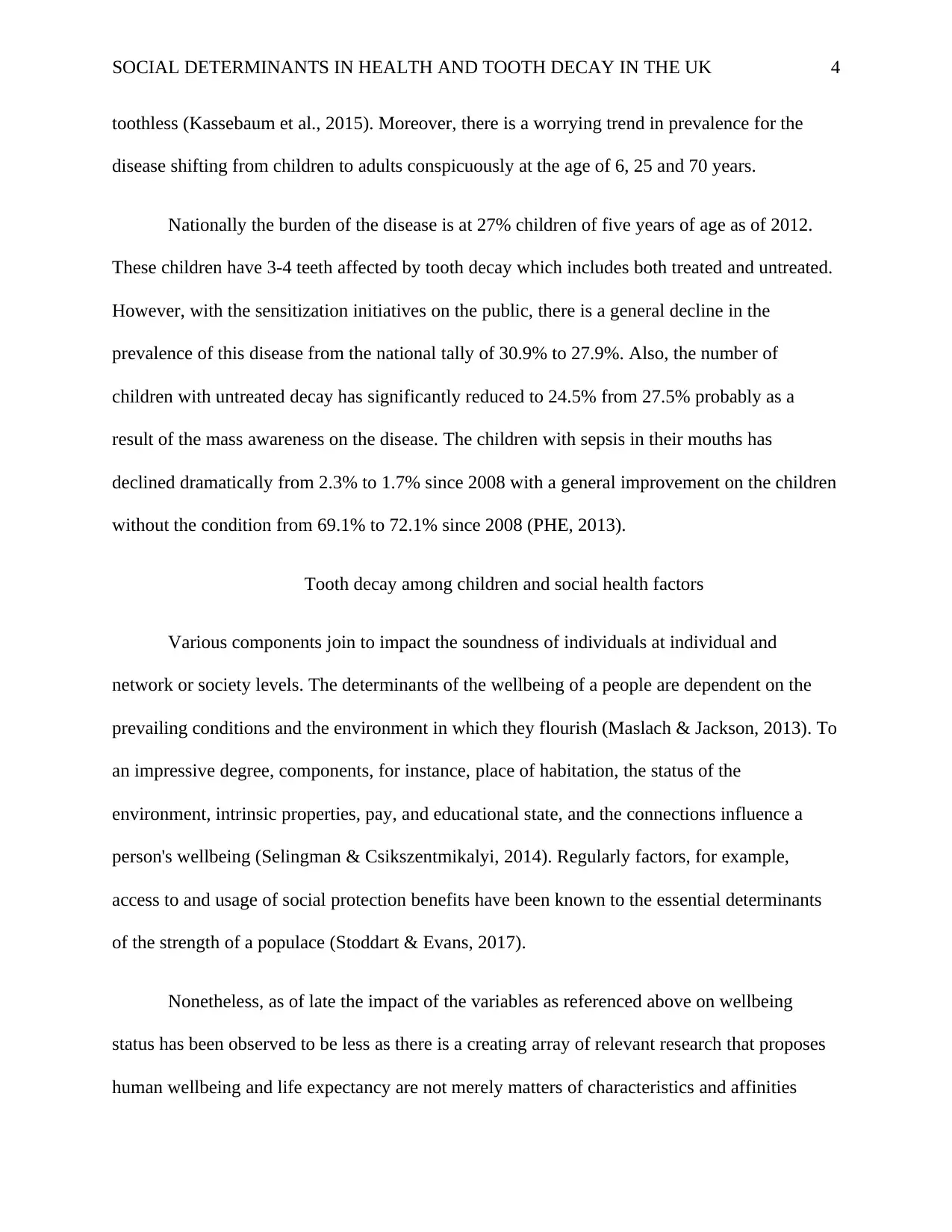
SOCIAL DETERMINANTS IN HEALTH AND TOOTH DECAY IN THE UK 4
toothless (Kassebaum et al., 2015). Moreover, there is a worrying trend in prevalence for the
disease shifting from children to adults conspicuously at the age of 6, 25 and 70 years.
Nationally the burden of the disease is at 27% children of five years of age as of 2012.
These children have 3-4 teeth affected by tooth decay which includes both treated and untreated.
However, with the sensitization initiatives on the public, there is a general decline in the
prevalence of this disease from the national tally of 30.9% to 27.9%. Also, the number of
children with untreated decay has significantly reduced to 24.5% from 27.5% probably as a
result of the mass awareness on the disease. The children with sepsis in their mouths has
declined dramatically from 2.3% to 1.7% since 2008 with a general improvement on the children
without the condition from 69.1% to 72.1% since 2008 (PHE, 2013).
Tooth decay among children and social health factors
Various components join to impact the soundness of individuals at individual and
network or society levels. The determinants of the wellbeing of a people are dependent on the
prevailing conditions and the environment in which they flourish (Maslach & Jackson, 2013). To
an impressive degree, components, for instance, place of habitation, the status of the
environment, intrinsic properties, pay, and educational state, and the connections influence a
person's wellbeing (Selingman & Csikszentmikalyi, 2014). Regularly factors, for example,
access to and usage of social protection benefits have been known to the essential determinants
of the strength of a populace (Stoddart & Evans, 2017).
Nonetheless, as of late the impact of the variables as referenced above on wellbeing
status has been observed to be less as there is a creating array of relevant research that proposes
human wellbeing and life expectancy are not merely matters of characteristics and affinities
toothless (Kassebaum et al., 2015). Moreover, there is a worrying trend in prevalence for the
disease shifting from children to adults conspicuously at the age of 6, 25 and 70 years.
Nationally the burden of the disease is at 27% children of five years of age as of 2012.
These children have 3-4 teeth affected by tooth decay which includes both treated and untreated.
However, with the sensitization initiatives on the public, there is a general decline in the
prevalence of this disease from the national tally of 30.9% to 27.9%. Also, the number of
children with untreated decay has significantly reduced to 24.5% from 27.5% probably as a
result of the mass awareness on the disease. The children with sepsis in their mouths has
declined dramatically from 2.3% to 1.7% since 2008 with a general improvement on the children
without the condition from 69.1% to 72.1% since 2008 (PHE, 2013).
Tooth decay among children and social health factors
Various components join to impact the soundness of individuals at individual and
network or society levels. The determinants of the wellbeing of a people are dependent on the
prevailing conditions and the environment in which they flourish (Maslach & Jackson, 2013). To
an impressive degree, components, for instance, place of habitation, the status of the
environment, intrinsic properties, pay, and educational state, and the connections influence a
person's wellbeing (Selingman & Csikszentmikalyi, 2014). Regularly factors, for example,
access to and usage of social protection benefits have been known to the essential determinants
of the strength of a populace (Stoddart & Evans, 2017).
Nonetheless, as of late the impact of the variables as referenced above on wellbeing
status has been observed to be less as there is a creating array of relevant research that proposes
human wellbeing and life expectancy are not merely matters of characteristics and affinities
Paraphrase This Document
Need a fresh take? Get an instant paraphrase of this document with our AI Paraphraser
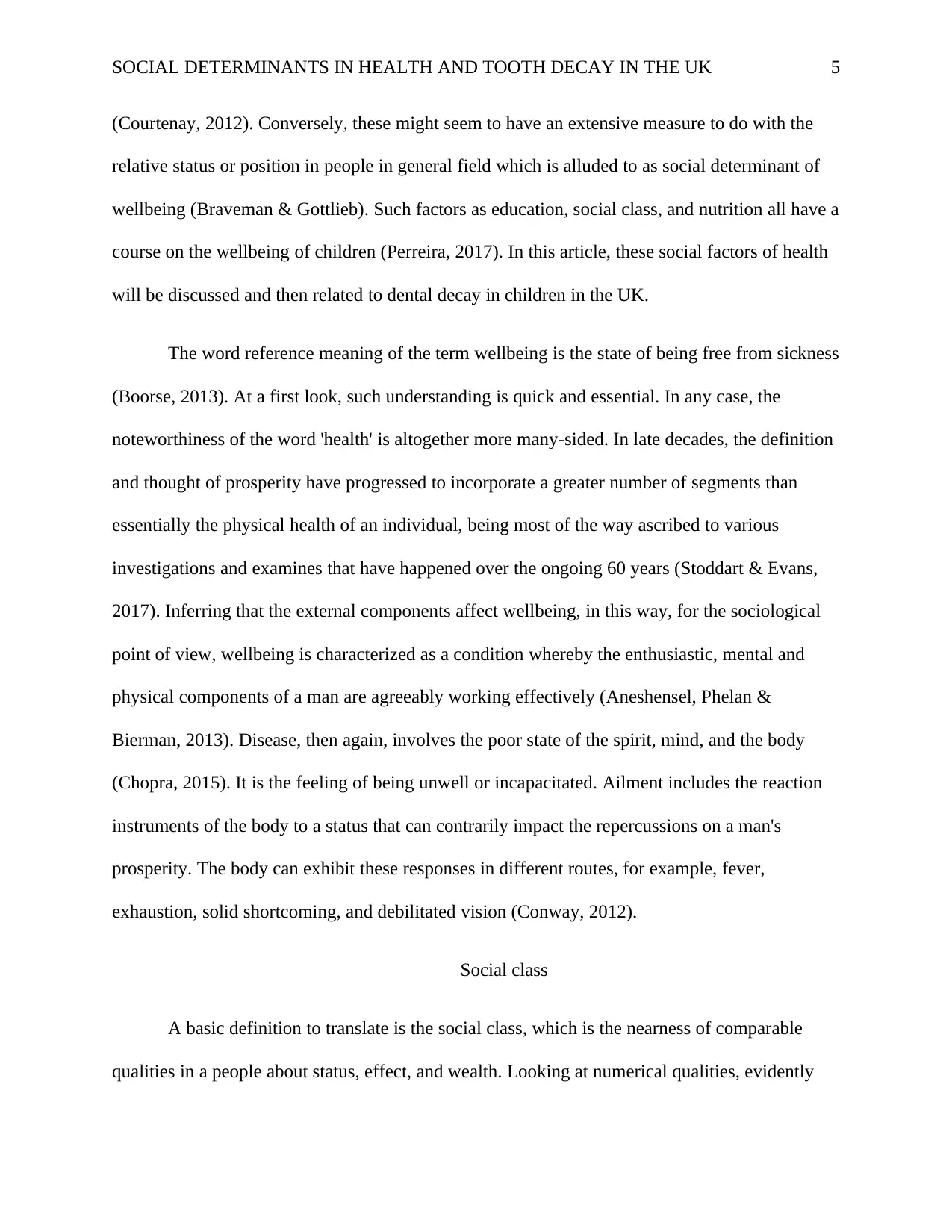
SOCIAL DETERMINANTS IN HEALTH AND TOOTH DECAY IN THE UK 5
(Courtenay, 2012). Conversely, these might seem to have an extensive measure to do with the
relative status or position in people in general field which is alluded to as social determinant of
wellbeing (Braveman & Gottlieb). Such factors as education, social class, and nutrition all have a
course on the wellbeing of children (Perreira, 2017). In this article, these social factors of health
will be discussed and then related to dental decay in children in the UK.
The word reference meaning of the term wellbeing is the state of being free from sickness
(Boorse, 2013). At a first look, such understanding is quick and essential. In any case, the
noteworthiness of the word 'health' is altogether more many-sided. In late decades, the definition
and thought of prosperity have progressed to incorporate a greater number of segments than
essentially the physical health of an individual, being most of the way ascribed to various
investigations and examines that have happened over the ongoing 60 years (Stoddart & Evans,
2017). Inferring that the external components affect wellbeing, in this way, for the sociological
point of view, wellbeing is characterized as a condition whereby the enthusiastic, mental and
physical components of a man are agreeably working effectively (Aneshensel, Phelan &
Bierman, 2013). Disease, then again, involves the poor state of the spirit, mind, and the body
(Chopra, 2015). It is the feeling of being unwell or incapacitated. Ailment includes the reaction
instruments of the body to a status that can contrarily impact the repercussions on a man's
prosperity. The body can exhibit these responses in different routes, for example, fever,
exhaustion, solid shortcoming, and debilitated vision (Conway, 2012).
Social class
A basic definition to translate is the social class, which is the nearness of comparable
qualities in a people about status, effect, and wealth. Looking at numerical qualities, evidently
(Courtenay, 2012). Conversely, these might seem to have an extensive measure to do with the
relative status or position in people in general field which is alluded to as social determinant of
wellbeing (Braveman & Gottlieb). Such factors as education, social class, and nutrition all have a
course on the wellbeing of children (Perreira, 2017). In this article, these social factors of health
will be discussed and then related to dental decay in children in the UK.
The word reference meaning of the term wellbeing is the state of being free from sickness
(Boorse, 2013). At a first look, such understanding is quick and essential. In any case, the
noteworthiness of the word 'health' is altogether more many-sided. In late decades, the definition
and thought of prosperity have progressed to incorporate a greater number of segments than
essentially the physical health of an individual, being most of the way ascribed to various
investigations and examines that have happened over the ongoing 60 years (Stoddart & Evans,
2017). Inferring that the external components affect wellbeing, in this way, for the sociological
point of view, wellbeing is characterized as a condition whereby the enthusiastic, mental and
physical components of a man are agreeably working effectively (Aneshensel, Phelan &
Bierman, 2013). Disease, then again, involves the poor state of the spirit, mind, and the body
(Chopra, 2015). It is the feeling of being unwell or incapacitated. Ailment includes the reaction
instruments of the body to a status that can contrarily impact the repercussions on a man's
prosperity. The body can exhibit these responses in different routes, for example, fever,
exhaustion, solid shortcoming, and debilitated vision (Conway, 2012).
Social class
A basic definition to translate is the social class, which is the nearness of comparable
qualities in a people about status, effect, and wealth. Looking at numerical qualities, evidently
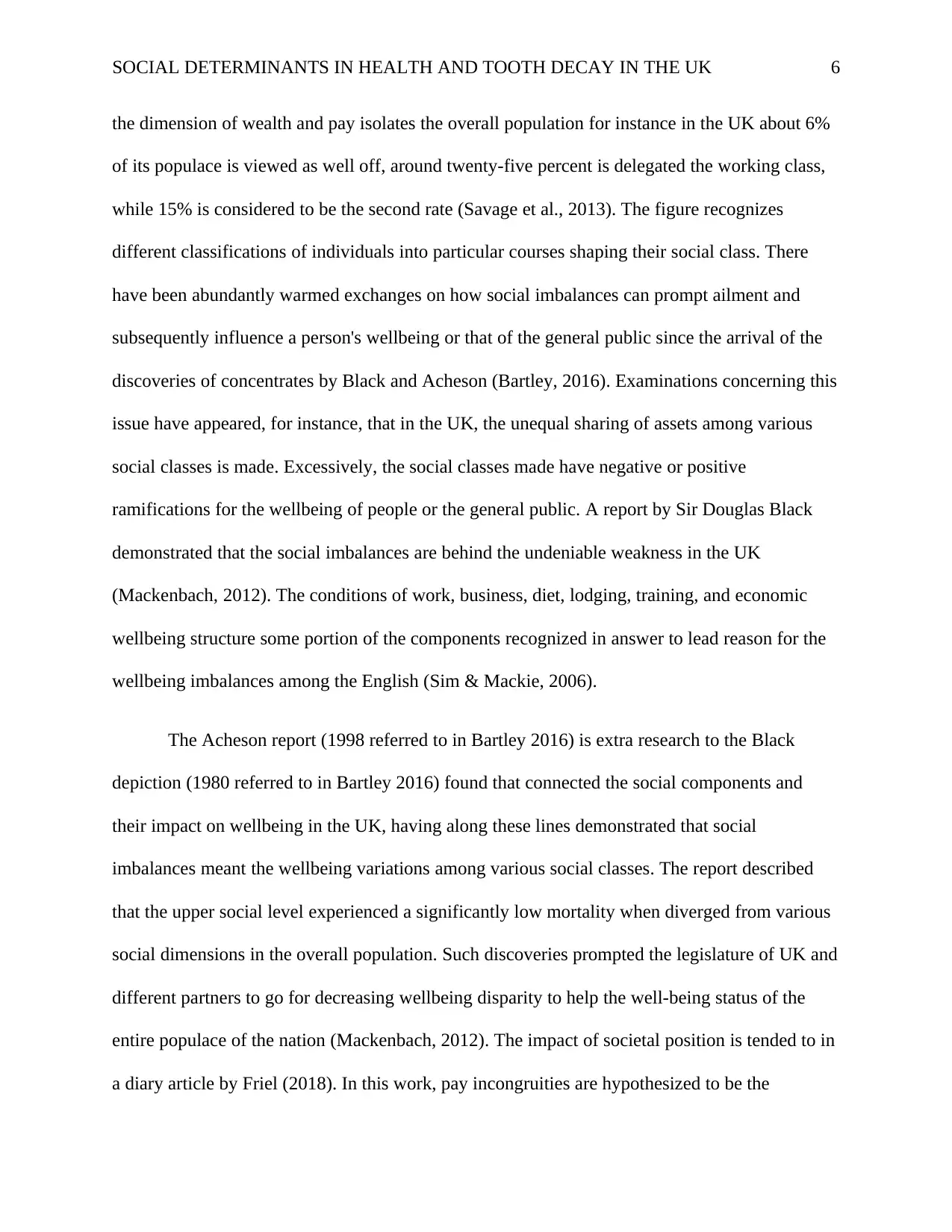
SOCIAL DETERMINANTS IN HEALTH AND TOOTH DECAY IN THE UK 6
the dimension of wealth and pay isolates the overall population for instance in the UK about 6%
of its populace is viewed as well off, around twenty-five percent is delegated the working class,
while 15% is considered to be the second rate (Savage et al., 2013). The figure recognizes
different classifications of individuals into particular courses shaping their social class. There
have been abundantly warmed exchanges on how social imbalances can prompt ailment and
subsequently influence a person's wellbeing or that of the general public since the arrival of the
discoveries of concentrates by Black and Acheson (Bartley, 2016). Examinations concerning this
issue have appeared, for instance, that in the UK, the unequal sharing of assets among various
social classes is made. Excessively, the social classes made have negative or positive
ramifications for the wellbeing of people or the general public. A report by Sir Douglas Black
demonstrated that the social imbalances are behind the undeniable weakness in the UK
(Mackenbach, 2012). The conditions of work, business, diet, lodging, training, and economic
wellbeing structure some portion of the components recognized in answer to lead reason for the
wellbeing imbalances among the English (Sim & Mackie, 2006).
The Acheson report (1998 referred to in Bartley 2016) is extra research to the Black
depiction (1980 referred to in Bartley 2016) found that connected the social components and
their impact on wellbeing in the UK, having along these lines demonstrated that social
imbalances meant the wellbeing variations among various social classes. The report described
that the upper social level experienced a significantly low mortality when diverged from various
social dimensions in the overall population. Such discoveries prompted the legislature of UK and
different partners to go for decreasing wellbeing disparity to help the well-being status of the
entire populace of the nation (Mackenbach, 2012). The impact of societal position is tended to in
a diary article by Friel (2018). In this work, pay incongruities are hypothesized to be the
the dimension of wealth and pay isolates the overall population for instance in the UK about 6%
of its populace is viewed as well off, around twenty-five percent is delegated the working class,
while 15% is considered to be the second rate (Savage et al., 2013). The figure recognizes
different classifications of individuals into particular courses shaping their social class. There
have been abundantly warmed exchanges on how social imbalances can prompt ailment and
subsequently influence a person's wellbeing or that of the general public since the arrival of the
discoveries of concentrates by Black and Acheson (Bartley, 2016). Examinations concerning this
issue have appeared, for instance, that in the UK, the unequal sharing of assets among various
social classes is made. Excessively, the social classes made have negative or positive
ramifications for the wellbeing of people or the general public. A report by Sir Douglas Black
demonstrated that the social imbalances are behind the undeniable weakness in the UK
(Mackenbach, 2012). The conditions of work, business, diet, lodging, training, and economic
wellbeing structure some portion of the components recognized in answer to lead reason for the
wellbeing imbalances among the English (Sim & Mackie, 2006).
The Acheson report (1998 referred to in Bartley 2016) is extra research to the Black
depiction (1980 referred to in Bartley 2016) found that connected the social components and
their impact on wellbeing in the UK, having along these lines demonstrated that social
imbalances meant the wellbeing variations among various social classes. The report described
that the upper social level experienced a significantly low mortality when diverged from various
social dimensions in the overall population. Such discoveries prompted the legislature of UK and
different partners to go for decreasing wellbeing disparity to help the well-being status of the
entire populace of the nation (Mackenbach, 2012). The impact of societal position is tended to in
a diary article by Friel (2018). In this work, pay incongruities are hypothesized to be the
⊘ This is a preview!⊘
Do you want full access?
Subscribe today to unlock all pages.

Trusted by 1+ million students worldwide
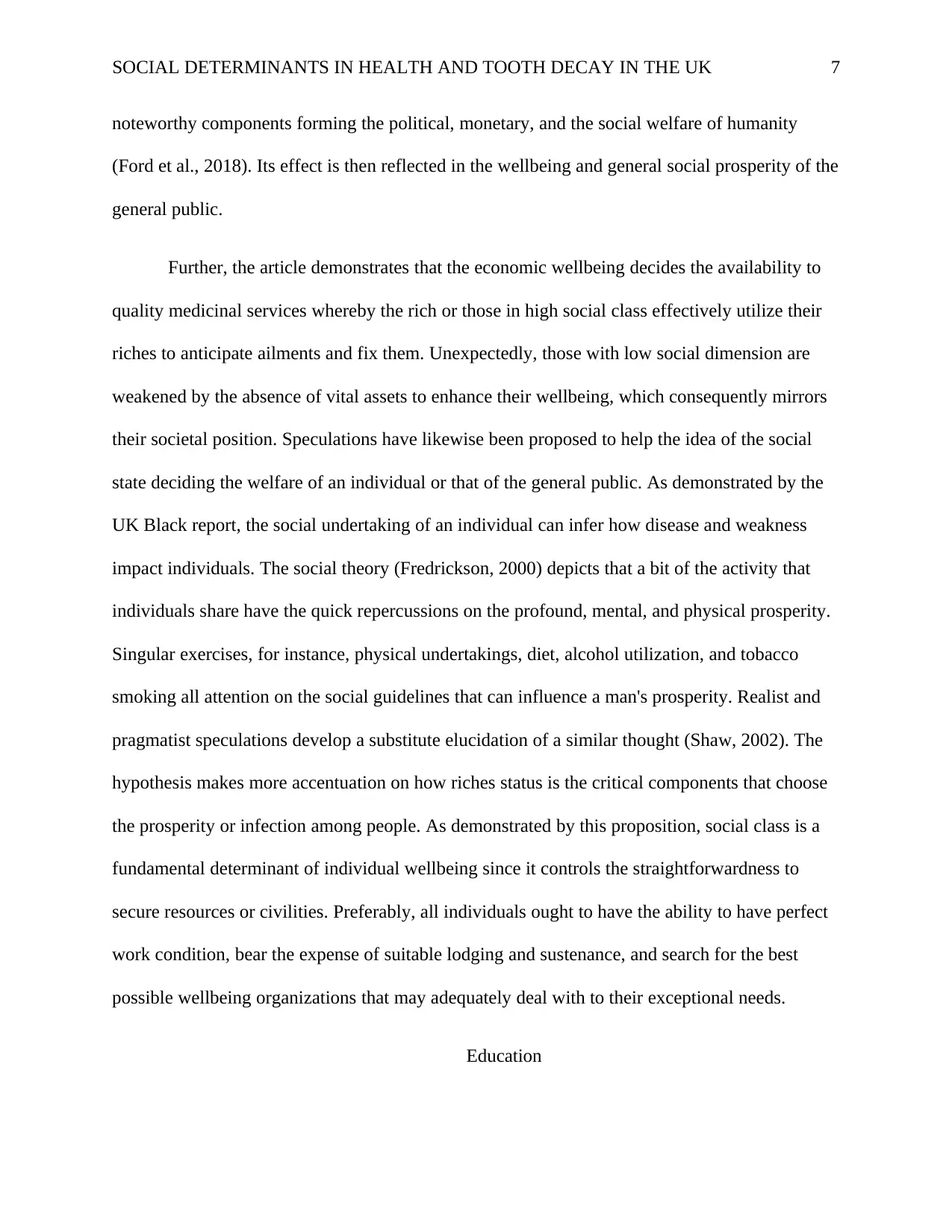
SOCIAL DETERMINANTS IN HEALTH AND TOOTH DECAY IN THE UK 7
noteworthy components forming the political, monetary, and the social welfare of humanity
(Ford et al., 2018). Its effect is then reflected in the wellbeing and general social prosperity of the
general public.
Further, the article demonstrates that the economic wellbeing decides the availability to
quality medicinal services whereby the rich or those in high social class effectively utilize their
riches to anticipate ailments and fix them. Unexpectedly, those with low social dimension are
weakened by the absence of vital assets to enhance their wellbeing, which consequently mirrors
their societal position. Speculations have likewise been proposed to help the idea of the social
state deciding the welfare of an individual or that of the general public. As demonstrated by the
UK Black report, the social undertaking of an individual can infer how disease and weakness
impact individuals. The social theory (Fredrickson, 2000) depicts that a bit of the activity that
individuals share have the quick repercussions on the profound, mental, and physical prosperity.
Singular exercises, for instance, physical undertakings, diet, alcohol utilization, and tobacco
smoking all attention on the social guidelines that can influence a man's prosperity. Realist and
pragmatist speculations develop a substitute elucidation of a similar thought (Shaw, 2002). The
hypothesis makes more accentuation on how riches status is the critical components that choose
the prosperity or infection among people. As demonstrated by this proposition, social class is a
fundamental determinant of individual wellbeing since it controls the straightforwardness to
secure resources or civilities. Preferably, all individuals ought to have the ability to have perfect
work condition, bear the expense of suitable lodging and sustenance, and search for the best
possible wellbeing organizations that may adequately deal with to their exceptional needs.
Education
noteworthy components forming the political, monetary, and the social welfare of humanity
(Ford et al., 2018). Its effect is then reflected in the wellbeing and general social prosperity of the
general public.
Further, the article demonstrates that the economic wellbeing decides the availability to
quality medicinal services whereby the rich or those in high social class effectively utilize their
riches to anticipate ailments and fix them. Unexpectedly, those with low social dimension are
weakened by the absence of vital assets to enhance their wellbeing, which consequently mirrors
their societal position. Speculations have likewise been proposed to help the idea of the social
state deciding the welfare of an individual or that of the general public. As demonstrated by the
UK Black report, the social undertaking of an individual can infer how disease and weakness
impact individuals. The social theory (Fredrickson, 2000) depicts that a bit of the activity that
individuals share have the quick repercussions on the profound, mental, and physical prosperity.
Singular exercises, for instance, physical undertakings, diet, alcohol utilization, and tobacco
smoking all attention on the social guidelines that can influence a man's prosperity. Realist and
pragmatist speculations develop a substitute elucidation of a similar thought (Shaw, 2002). The
hypothesis makes more accentuation on how riches status is the critical components that choose
the prosperity or infection among people. As demonstrated by this proposition, social class is a
fundamental determinant of individual wellbeing since it controls the straightforwardness to
secure resources or civilities. Preferably, all individuals ought to have the ability to have perfect
work condition, bear the expense of suitable lodging and sustenance, and search for the best
possible wellbeing organizations that may adequately deal with to their exceptional needs.
Education
Paraphrase This Document
Need a fresh take? Get an instant paraphrase of this document with our AI Paraphraser
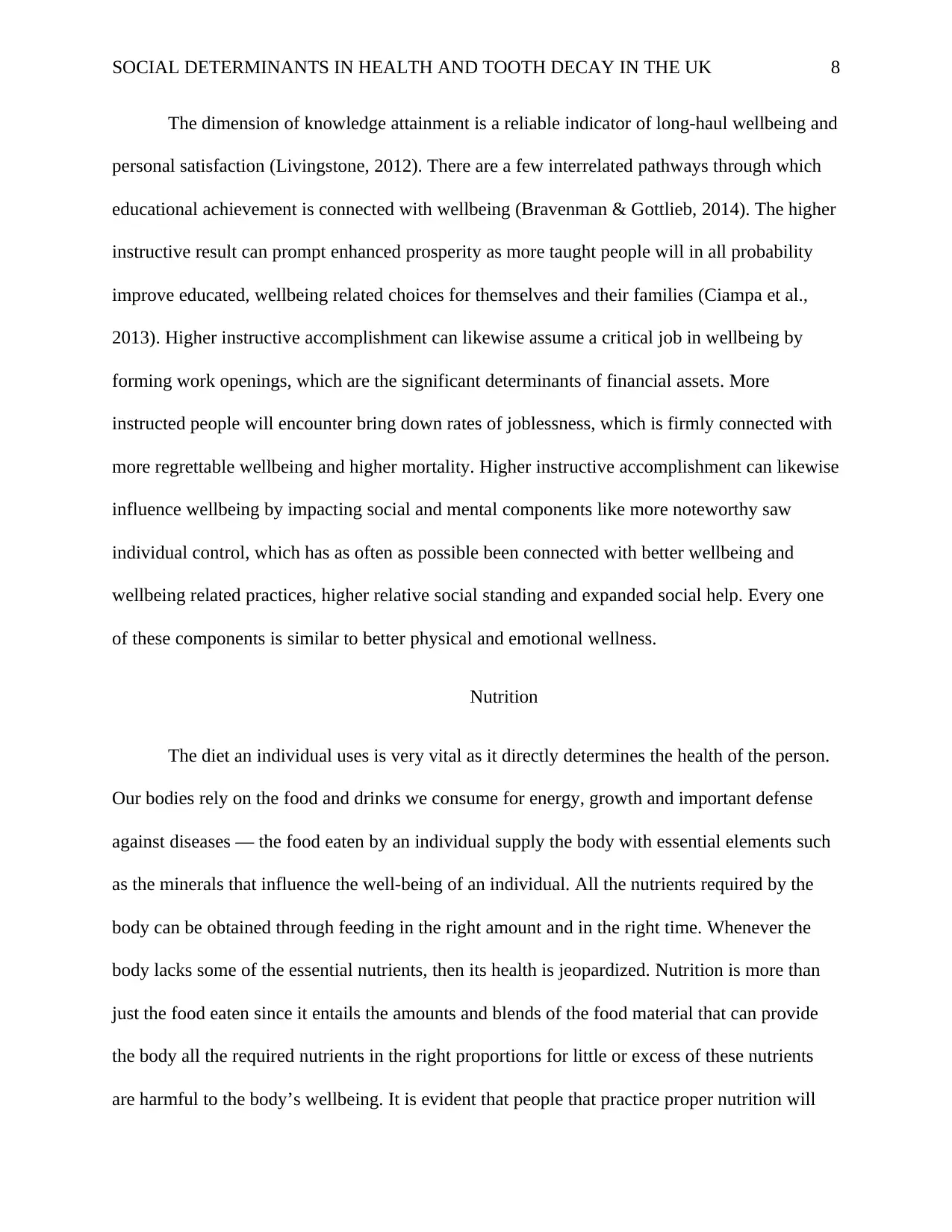
SOCIAL DETERMINANTS IN HEALTH AND TOOTH DECAY IN THE UK 8
The dimension of knowledge attainment is a reliable indicator of long-haul wellbeing and
personal satisfaction (Livingstone, 2012). There are a few interrelated pathways through which
educational achievement is connected with wellbeing (Bravenman & Gottlieb, 2014). The higher
instructive result can prompt enhanced prosperity as more taught people will in all probability
improve educated, wellbeing related choices for themselves and their families (Ciampa et al.,
2013). Higher instructive accomplishment can likewise assume a critical job in wellbeing by
forming work openings, which are the significant determinants of financial assets. More
instructed people will encounter bring down rates of joblessness, which is firmly connected with
more regrettable wellbeing and higher mortality. Higher instructive accomplishment can likewise
influence wellbeing by impacting social and mental components like more noteworthy saw
individual control, which has as often as possible been connected with better wellbeing and
wellbeing related practices, higher relative social standing and expanded social help. Every one
of these components is similar to better physical and emotional wellness.
Nutrition
The diet an individual uses is very vital as it directly determines the health of the person.
Our bodies rely on the food and drinks we consume for energy, growth and important defense
against diseases — the food eaten by an individual supply the body with essential elements such
as the minerals that influence the well-being of an individual. All the nutrients required by the
body can be obtained through feeding in the right amount and in the right time. Whenever the
body lacks some of the essential nutrients, then its health is jeopardized. Nutrition is more than
just the food eaten since it entails the amounts and blends of the food material that can provide
the body all the required nutrients in the right proportions for little or excess of these nutrients
are harmful to the body’s wellbeing. It is evident that people that practice proper nutrition will
The dimension of knowledge attainment is a reliable indicator of long-haul wellbeing and
personal satisfaction (Livingstone, 2012). There are a few interrelated pathways through which
educational achievement is connected with wellbeing (Bravenman & Gottlieb, 2014). The higher
instructive result can prompt enhanced prosperity as more taught people will in all probability
improve educated, wellbeing related choices for themselves and their families (Ciampa et al.,
2013). Higher instructive accomplishment can likewise assume a critical job in wellbeing by
forming work openings, which are the significant determinants of financial assets. More
instructed people will encounter bring down rates of joblessness, which is firmly connected with
more regrettable wellbeing and higher mortality. Higher instructive accomplishment can likewise
influence wellbeing by impacting social and mental components like more noteworthy saw
individual control, which has as often as possible been connected with better wellbeing and
wellbeing related practices, higher relative social standing and expanded social help. Every one
of these components is similar to better physical and emotional wellness.
Nutrition
The diet an individual uses is very vital as it directly determines the health of the person.
Our bodies rely on the food and drinks we consume for energy, growth and important defense
against diseases — the food eaten by an individual supply the body with essential elements such
as the minerals that influence the well-being of an individual. All the nutrients required by the
body can be obtained through feeding in the right amount and in the right time. Whenever the
body lacks some of the essential nutrients, then its health is jeopardized. Nutrition is more than
just the food eaten since it entails the amounts and blends of the food material that can provide
the body all the required nutrients in the right proportions for little or excess of these nutrients
are harmful to the body’s wellbeing. It is evident that people that practice proper nutrition will

SOCIAL DETERMINANTS IN HEALTH AND TOOTH DECAY IN THE UK 9
have good health as by having a balanced diet. Food or menu of an individual is also influenced
by other social determinants such as education and social class that is dependent on wealth or
employment. A high social level can get the foods required for a daily balanced diet unlike the
poor that stain obtains a typical meal.
Moreover, high social classes mostly are learned people that have the appropriate data on
a diet and how to achieve it. So illiteracy can bring about poor nutrition levels of a society of
individual which acts as a predisposition for illness hence poor health. For young children, their
parents require knowledge of a diet for them to feed their children with proper food preventing
them from being vulnerable to diseases. Dental decay is mostly brought about by poor nutrition
and hygiene. Knowledge of good nutrition also entails maintaining the proper function and state
of the body through cleanliness of the mouth thereby preventing dental decay. Besides, some
nutrients such as calcium are essential for health tooth formation which can be acquired through
proper nutrition.
Conclusions
It is worth noting that mass education programs through various channels such as the
mass media and social media are one of the most appropriate mechanisms for curbing this global
health threat of dental decay. As the general public becomes empowered with knowledge on the
disease, then it is possible for every individual to be in a position of preventing and treating the
disease. As the above statistics prove, the condition is controllable when it is handled in its early
stages by regularly visiting healthcare facilities for a checkup. Most of the disease cases are those
that were not treated when the victims were at the age of five years, a reason for the shift in
prevalence form children to adults.
have good health as by having a balanced diet. Food or menu of an individual is also influenced
by other social determinants such as education and social class that is dependent on wealth or
employment. A high social level can get the foods required for a daily balanced diet unlike the
poor that stain obtains a typical meal.
Moreover, high social classes mostly are learned people that have the appropriate data on
a diet and how to achieve it. So illiteracy can bring about poor nutrition levels of a society of
individual which acts as a predisposition for illness hence poor health. For young children, their
parents require knowledge of a diet for them to feed their children with proper food preventing
them from being vulnerable to diseases. Dental decay is mostly brought about by poor nutrition
and hygiene. Knowledge of good nutrition also entails maintaining the proper function and state
of the body through cleanliness of the mouth thereby preventing dental decay. Besides, some
nutrients such as calcium are essential for health tooth formation which can be acquired through
proper nutrition.
Conclusions
It is worth noting that mass education programs through various channels such as the
mass media and social media are one of the most appropriate mechanisms for curbing this global
health threat of dental decay. As the general public becomes empowered with knowledge on the
disease, then it is possible for every individual to be in a position of preventing and treating the
disease. As the above statistics prove, the condition is controllable when it is handled in its early
stages by regularly visiting healthcare facilities for a checkup. Most of the disease cases are those
that were not treated when the victims were at the age of five years, a reason for the shift in
prevalence form children to adults.
⊘ This is a preview!⊘
Do you want full access?
Subscribe today to unlock all pages.

Trusted by 1+ million students worldwide

SOCIAL DETERMINANTS IN HEALTH AND TOOTH DECAY IN THE UK 10
Another important aspect of solving health disparities among different population
demographics is by the reducing of the social gap through equal distribution of resources and
access to healthcare facilities and services.
Another important aspect of solving health disparities among different population
demographics is by the reducing of the social gap through equal distribution of resources and
access to healthcare facilities and services.
Paraphrase This Document
Need a fresh take? Get an instant paraphrase of this document with our AI Paraphraser
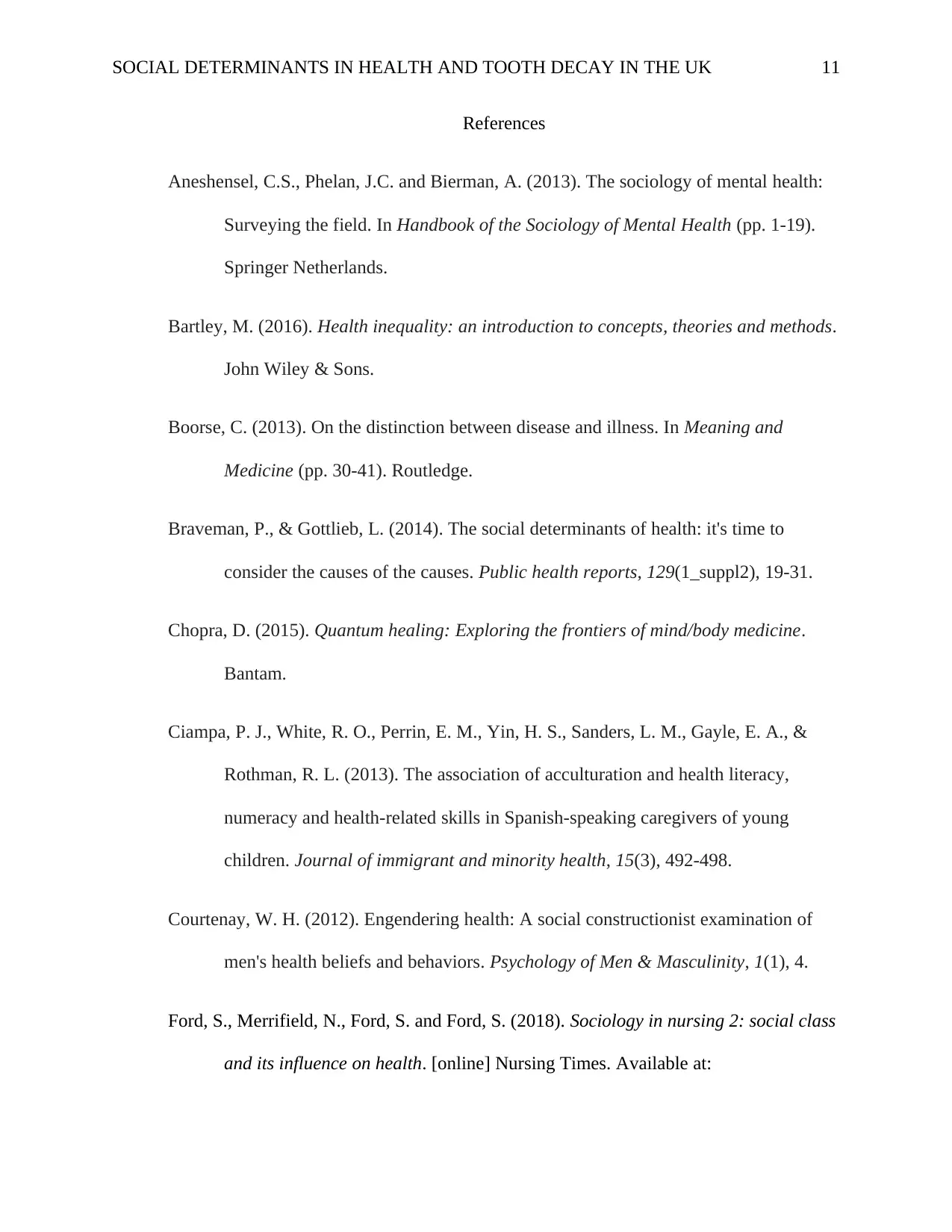
SOCIAL DETERMINANTS IN HEALTH AND TOOTH DECAY IN THE UK 11
References
Aneshensel, C.S., Phelan, J.C. and Bierman, A. (2013). The sociology of mental health:
Surveying the field. In Handbook of the Sociology of Mental Health (pp. 1-19).
Springer Netherlands.
Bartley, M. (2016). Health inequality: an introduction to concepts, theories and methods.
John Wiley & Sons.
Boorse, C. (2013). On the distinction between disease and illness. In Meaning and
Medicine (pp. 30-41). Routledge.
Braveman, P., & Gottlieb, L. (2014). The social determinants of health: it's time to
consider the causes of the causes. Public health reports, 129(1_suppl2), 19-31.
Chopra, D. (2015). Quantum healing: Exploring the frontiers of mind/body medicine.
Bantam.
Ciampa, P. J., White, R. O., Perrin, E. M., Yin, H. S., Sanders, L. M., Gayle, E. A., &
Rothman, R. L. (2013). The association of acculturation and health literacy,
numeracy and health-related skills in Spanish-speaking caregivers of young
children. Journal of immigrant and minority health, 15(3), 492-498.
Courtenay, W. H. (2012). Engendering health: A social constructionist examination of
men's health beliefs and behaviors. Psychology of Men & Masculinity, 1(1), 4.
Ford, S., Merrifield, N., Ford, S. and Ford, S. (2018). Sociology in nursing 2: social class
and its influence on health. [online] Nursing Times. Available at:
References
Aneshensel, C.S., Phelan, J.C. and Bierman, A. (2013). The sociology of mental health:
Surveying the field. In Handbook of the Sociology of Mental Health (pp. 1-19).
Springer Netherlands.
Bartley, M. (2016). Health inequality: an introduction to concepts, theories and methods.
John Wiley & Sons.
Boorse, C. (2013). On the distinction between disease and illness. In Meaning and
Medicine (pp. 30-41). Routledge.
Braveman, P., & Gottlieb, L. (2014). The social determinants of health: it's time to
consider the causes of the causes. Public health reports, 129(1_suppl2), 19-31.
Chopra, D. (2015). Quantum healing: Exploring the frontiers of mind/body medicine.
Bantam.
Ciampa, P. J., White, R. O., Perrin, E. M., Yin, H. S., Sanders, L. M., Gayle, E. A., &
Rothman, R. L. (2013). The association of acculturation and health literacy,
numeracy and health-related skills in Spanish-speaking caregivers of young
children. Journal of immigrant and minority health, 15(3), 492-498.
Courtenay, W. H. (2012). Engendering health: A social constructionist examination of
men's health beliefs and behaviors. Psychology of Men & Masculinity, 1(1), 4.
Ford, S., Merrifield, N., Ford, S. and Ford, S. (2018). Sociology in nursing 2: social class
and its influence on health. [online] Nursing Times. Available at:

SOCIAL DETERMINANTS IN HEALTH AND TOOTH DECAY IN THE UK 12
https://www.nursingtimes.net/clinical-archive/public-health/sociology-in-nursing-
2-social-class-and-its-influence-on-health/5091017
Fredrickson, B.L. (2000). Cultivating positive emotions to optimize health and well-
being. Prevention & treatment, 3(1), p.1a.
Friel, S. (2018). How social class affects health. [online] The Conversation. Available at:
https://theconversation.com/how-social-class-affects-health-23366
Kassebaum, N., Bernabé, E., Dahiya, M., Bhandari, B., Murray, C., & Marcenes, W.
(2015). Global Burden of Untreated Caries. Journal of Dental Research, 94(5),
650-658. doi:10.1177/0022034515573272
Livingstone, D. W. (2012). Probing the icebergs of adult learning: Comparative findings
and implications of the 1998, 2004 and 2010 Canadian surveys of formal and
informal learning practices. The Canadian Journal for the Study of Adult
Education (Online), 25(1), 47.
Mackenbach, J.P.(2012). The persistence of health inequalities in modern welfare states:
the explanation of a paradox. Social Science & Medicine, 75(4), pp.761-769.
Maslach, C., & Jackson, S. E. (2013). A social psychological analysis. Social psychology
of health and illness, 227.
Perreira, M. (2017). What is illness? What is health? - ucanews.com. Retrieved from
https://www.ucanews.com/news/what-is-illness-what-is-health/78298
https://www.nursingtimes.net/clinical-archive/public-health/sociology-in-nursing-
2-social-class-and-its-influence-on-health/5091017
Fredrickson, B.L. (2000). Cultivating positive emotions to optimize health and well-
being. Prevention & treatment, 3(1), p.1a.
Friel, S. (2018). How social class affects health. [online] The Conversation. Available at:
https://theconversation.com/how-social-class-affects-health-23366
Kassebaum, N., Bernabé, E., Dahiya, M., Bhandari, B., Murray, C., & Marcenes, W.
(2015). Global Burden of Untreated Caries. Journal of Dental Research, 94(5),
650-658. doi:10.1177/0022034515573272
Livingstone, D. W. (2012). Probing the icebergs of adult learning: Comparative findings
and implications of the 1998, 2004 and 2010 Canadian surveys of formal and
informal learning practices. The Canadian Journal for the Study of Adult
Education (Online), 25(1), 47.
Mackenbach, J.P.(2012). The persistence of health inequalities in modern welfare states:
the explanation of a paradox. Social Science & Medicine, 75(4), pp.761-769.
Maslach, C., & Jackson, S. E. (2013). A social psychological analysis. Social psychology
of health and illness, 227.
Perreira, M. (2017). What is illness? What is health? - ucanews.com. Retrieved from
https://www.ucanews.com/news/what-is-illness-what-is-health/78298
⊘ This is a preview!⊘
Do you want full access?
Subscribe today to unlock all pages.

Trusted by 1+ million students worldwide
1 out of 14
Related Documents
Your All-in-One AI-Powered Toolkit for Academic Success.
+13062052269
info@desklib.com
Available 24*7 on WhatsApp / Email
![[object Object]](/_next/static/media/star-bottom.7253800d.svg)
Unlock your academic potential
Copyright © 2020–2025 A2Z Services. All Rights Reserved. Developed and managed by ZUCOL.





